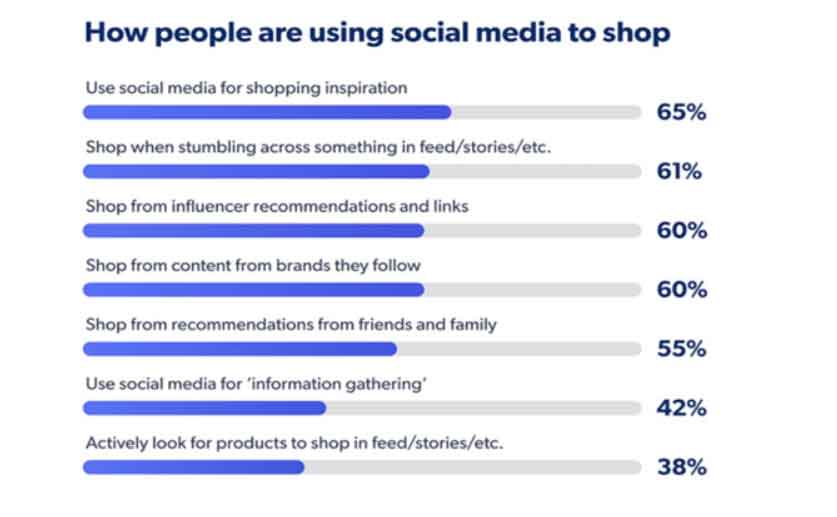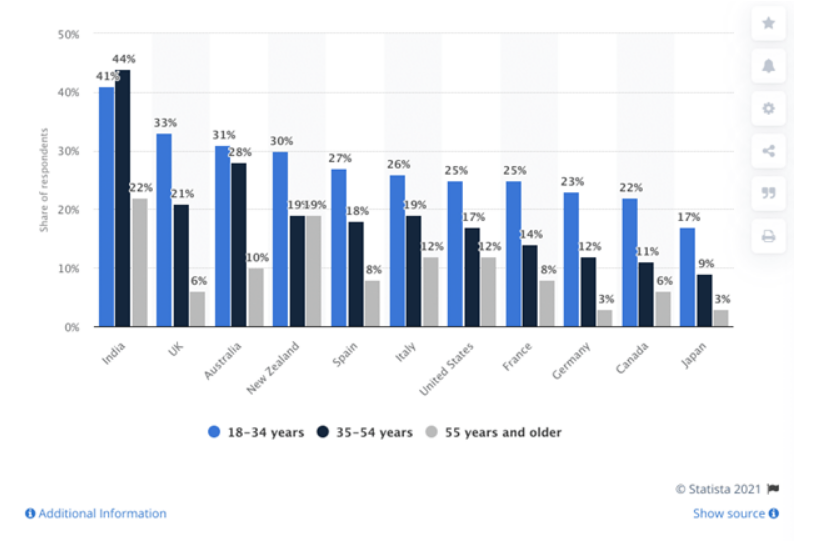The e-commerce landscape still proceeds to prosper in 2022. Two years on from Covid-19’s digital shift, e-commerce based sales have all but doubled online, as both companies and consumers adapt to new forms of digital selling.
From a mobile commerce boom to app based selling, there are now a number of ways to interact with the e-commerce landscape from the comfort of your own home. On the back of a high street decline, mobile commerce for example was up by 72% in 2021, remaining the most popular vessel for online shopping.
With a spike in mobile and app based purchasing, comes a spike in social media shopping. With over 4.62 billion mobile users also logged into at least one social platform, social selling has begun to take off in a post-pandemic playing field.
As consumers browse TikTok, Instagram and Facebook, looking for their next purchase inspiration, smart marketers need to be on top of their social selling game. From improving conversational content creation to introducing new social listening techniques into the sales process, the outbound selling funnel of the future is social.
Read on as we discuss the changing consumer attitudes of a post-pandemic demographic and divulge our best kept social selling secrets, that will leave you monopolising the social platforms of tomorrow.
Addressing Changing Consumer Attitudes In 2022
It’s no secret that consumer attitudes are changing in the wake of the digital shift. With a significant focus on mobile based e-commerce, digitally native consumers demand a more interactive, personalised shopping experience.
Today’s e-commerce demographic expects a brand to find them, hook them and pledge an alliance to their values. In fact, according to a recent report from Mckinsey, 80% of Gen Z and Millenial consumers demand a completely personalised experience from a company, or they will simply jump to a competitor.
In a fiercely competitive e-commerce playing field, social commerce has begun to prosper in response, as brands have access to a global platform audience, can blend in organically with niche demographic content and connect with their potential leads on a personal level.
Alongside this, consumers are also finding new ways to utilise social media for their e-commerce needs. For example, over half of all platform users, utilise social applications for shopping inspiration, to shop from influencer recommendations and interact with branded content.

With TikTok dominating as a front runner for social commerce success in 2022, consumer content demands have also transformed in the wake of the video-based app’s lockdown triumph.
E-commerce retailers need to be revamping their content game in 2022 in order to address an increasing consumer demand for more video based content. On the back of TikTok’s 30-second snippet format, 86% of e-commerce companies incorporated video content into their strategy in 2021. While phone and email selling may have prospered a decade ago, consumer capturing content now needs to be fresh, gripping and digitally immersive if sales reps and smart marketers want consumers to connect.
Is Social Selling The Key To Success?
If you dont want to take our word for it, let’s look at the stats. Social selling has been ranked as one of the best strategies for selling success since the onset of the pandemic after a Hootsuite study deemed business leaders who utilised social selling tactics, 45% more likely to see higher sales lead conversions.
Better still, the same study revealed that just under 80% of companies that use just one form of social selling, would completely outsell their competitors in a 2022 landscape.
Alongside this, we must address the post-covid social selling boom. In the last quarter of 2020 alone, over a quarter of US shoppers stated that they had made at least a single purchase off of a social platform, with consumers between the ages of 18-34 leading the trend forward.

Since then, the social selling strategy has continued to generate a number of benefits for e-commerce sales reps. Not only does it allow a sales team to make a real connection with their demographic, but gathering more insights on what consumers are interacting and engaging with across their social platforms, can aid strategy planning for the future, and help companies predict the next consumer trend.
Meet The Social Selling Strategies Of The Future
The art of social selling can be tricky within a competitive landscape. Sales reps who want to bask in the success, need to know their audience inside and out, and most importantly understand how social content creation works and what makes it go viral.
While social selling can appear similar to content marketing, the techniques differ. While content marketing reels a consumer onto a brand’s social page, social selling is all about creating a connection and keeping your potential leads interested.
Social sellers need to know how to keep a conversation flowing over social media and be actively searching for new content trends that they can incorporate into their brand strategy. Social sellers are the voice of the brand and can be the difference between a browse and a link follow.
Here are some of the best tactics to incorporate into your strategy for ultimate success.
Do Your Audience Research
No sales strategy is complete without audience research. The key to monopolising your social channels is to know your demographic inside and out. It’s time to start taking audits of your current buyers and the audience you are aiming to target with your social selling.
Using analytic tools such as Google Analytics and Finteza offers a quick window into what makes your audience tick and click, what content is providing the highest level of engagement and of course your demographic’s characteristics, such as age, location and preferred platform.
With consumer insights in mind, social sellers are much more likely to create meaningful, personalised connections with a social platform audience, and put out content that matches a lead target’s values.
Switch Up Those Cross Platform Tactics
The key to achieving a strong social selling strategy is diversifying your cross-platform tactics. While interactive video based content may work on TikTok, the same tactic may fall flat on more professional platforms such as Linkedin.
After gathering insights into your cross-platform targets, start playing with your tone of voice in order to keep conversations flowing across the board. The key here is to review your content writing skills and adapt your voice to appeal to the desired platform.
Switching up your tactics to address platform trends, will allow you to blend into consumers’ feed organically.
Prioritise Customer Retention
Last but not least, it’s important to keep your customers coming back to you on social media. It is six times more expensive to win over a new sales lead than retain an existing one.
You want existing customers to keep coming back to your social channels as they will be more likely to share your content on their own platforms, in return improving brand awareness.
It’s important to nurture a sales based relationship on social media. Ask your existing consumers questions that relate directly to their personal experience, offer discounts and incentives and gather insight into their own platform bio’s. Striving to keep existing customers engaged will make them more likely to interact with the brand on a regular basis and repurchase.



































